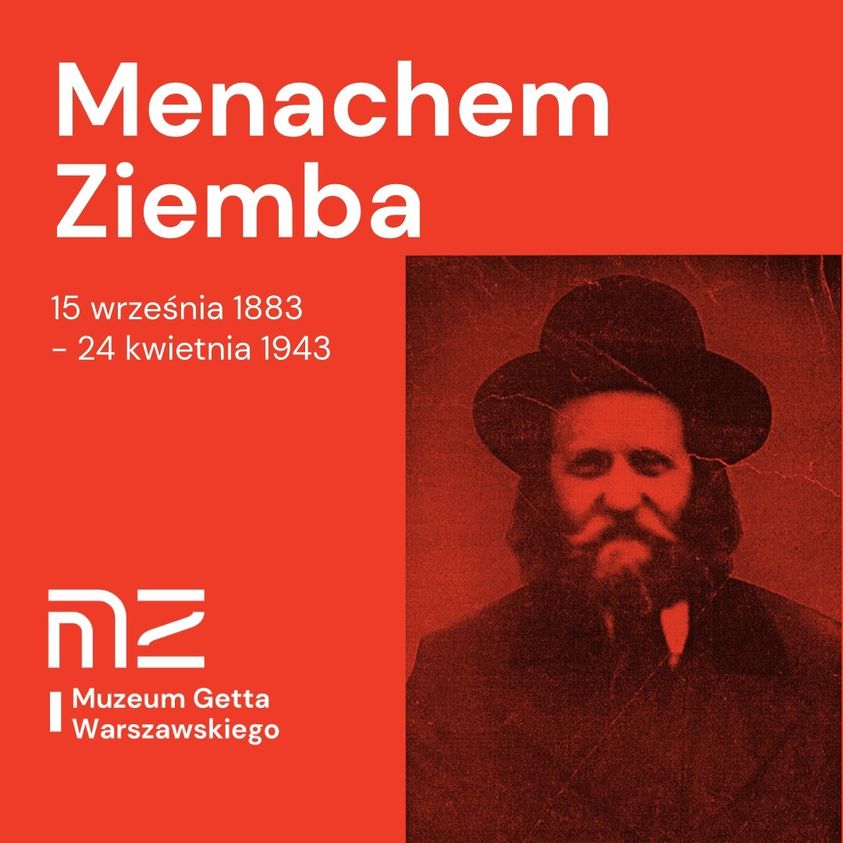rabbi Menachem Ziemba (15.10.1883–24.04.1943)
called the Gaon from Warsaw, the Warsaw Gaon or Menachem Pragier, one of the rabbis of the Warsaw ghetto, author of religious works and sacred texts scholar, activist of Agudos Isroel

Rabbi Menachem Ziemba was born in 1883 in the Praga district of Warsaw. From a young age, he was considered an outstanding expert on the Torah. He lost his father at the age of 9 and was brought up by his grandfather, who encouraged him to go to the tzadik of Góra Kalwaria, Rabbi Arie Lejb Alter. After getting married, he moved to his father-in-law’s house at ul. Brukowa 34 in Praga. In 1935 he was elected Chief Rabbi of Warsaw.
After the occupation of Warsaw by the Germans, Ziemba expressed his desire to join the Council of Elders, but this was met with opposition from other chief rabbis. In the winter of 1940, he was arrested by the Germans, who tortured him in order to force him to disclose information about the whereabouts of wealthy Jews. Ziemba refused to give any details and was badly beaten. Then the Germans went to his house, where a group of Jews gathered who planned to collect money for a ransom, thanks to which they were to release the rabbi. The Germans accepted the money and released the prisoner.
The rabbi then moved from one place of residence to another until the ghetto was established. As he was not able to carry thousands of pages of manuscript with him from house to house, he hid most of them in the attic of the building at 15 Karmelicka Street. During the ‘Great Liquidation Action’, the mass deportation carried out in the summer of 1942, his wife and daughters were transported to the extermination camp in Treblinka. Rabbi Menachem was forced to change his place of residence again and moved to Muranowska Street. A visa to Paraguay was sent from Switzerland for the rabbi, but he refused to use it. At the end of the ghetto’s existence, many people searched for Rabbi Menachem’s wisdom. He advised those who could escape to hide outside the ghetto, and to those who were unable to hide in bunkers.
On the eve of Pesach, in preparation for the final liquidation action, the Warsaw ghetto was surrounded. After entering the ghetto, the Germans encountered resistance from Jewish combat groups. Rabbi Menachem with a group of about a hundred people hid in the ‘bunker’ in the attic. That evening, on the first night of Pesach, Rabbi Ziemba left his hiding place and held a traditional Seder dinner in his apartment.
On the Sabbath, April 24, the flames of the ghetto destroyed and burned by the Germans reached Kupiecka Street. The fire approaching the bunker where Rabbi Menachem was staying forced the people in hiding to flee. They decided to try to get to the other side of the street, to number 4, where Rabbi Dow Ber from Ozorków was hiding with others. During this attempt, Rabbi Menachem was shot dead by the Germans waiting in the ruins of Nalewka 39. That evening, under the cover of night, the body of Rabbi Menachem Ziemba was found and buried in the courtyard of the house at ul. Kupiecka 4.
In 1958, the rabbi’s grave was found and the remains were transported to Jerusalem and buried in the Har Ha-Menuchot cemetery.
translated by Adam Grossman

